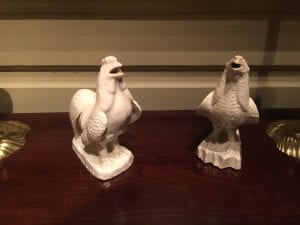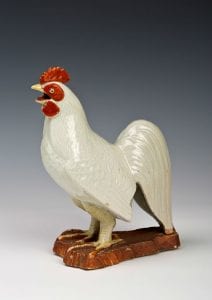The Many Iterations of a Much Beloved Form
By Anastasia Kinigopoulo, WPAMC Class of 2020
From the beginning, I knew that I wanted to do a figure for my oral presentation in Leslie Grigsby’s ceramics connoisseurship course. With so many figures in the Winterthur collection to chose from, settling on one proved a challenge. Exploring (and finding myself lost in) the house, I kept being drawn to two ceramic cockerels, particularly the one made of milky white porcelain. There was just something about his open beak that I found irresistibly appealing.

Blanc de Chine figure of a rooster, Winterthur Museum 2003.0013.113. Photograph by the author.
This figure was produced in the late 17th or early 18th century in Dehua, a county in China’s Fujian provenience. Unlike the better-known Jingdezhen kilns, which produced the blue and white and polychrome objects, Dehua kilns made pure white porcelain with a silky alkaline lime glaze. In the 19th century, these white porcelain objects began to be called blanc de Chine, a term that many still use. Some scholars suspect that the association of death with the color white in Chinese culture may be the reason that Dehua never received imperial support as did the Jingdezhen kilns. Indeed, Dehua wares were more popular outside of China and largely created for foreign markets. The West, for instance, imported thousands of objects from this region throughout the 17th and 18th centuries, many of which were figures like this rooster.
When I began researching this particular specimen, I was surprised by just how many iterations of this figure were produced. Though not all of them had quite the charm of Winterthur’s rooster, the presence of so many other examples speaks to the popularity of this specific form, which was essentially mass produced for export.

Blanc de Chine rooster with English salt-glazed stoneware imitation. Winterthur Museum 2003.0013.113 and 2003.0013.112. Photograph by the author.
Moreover, not only were Dehua potters creating these figures, but potters and metal workers in other regions also made their own versions of the rooster-on-a-rock motif. This rooster’s companion, for example, is an English-made copy produced in salt-glazed stoneware.

Unknown Chinese artist, Incense Burner in the Shape of a Rooster, 18th Century. Image courtesy the Metropolitan Museum of Art.
The Metropolitan Museum of Art, meanwhile, has in its collection a Chinese cloisonné incense holder which also echoes this form.

A figure of a cockerel, Japanese, late 17th Century. Image courtesy the Burghley Collection, England.
And, the Burghley house in England owns an 18th century Japanese porcelain rooster that may have been the inspiration for this one…or was it the other way around?
Across the centuries, myself and countless other people from disparate countries and continents found this particular form so satisfying that they were moved to recreate it again and again in a variety of materials. It turns out that I’m far from the only one drawn to this little figure.

Leave a Reply